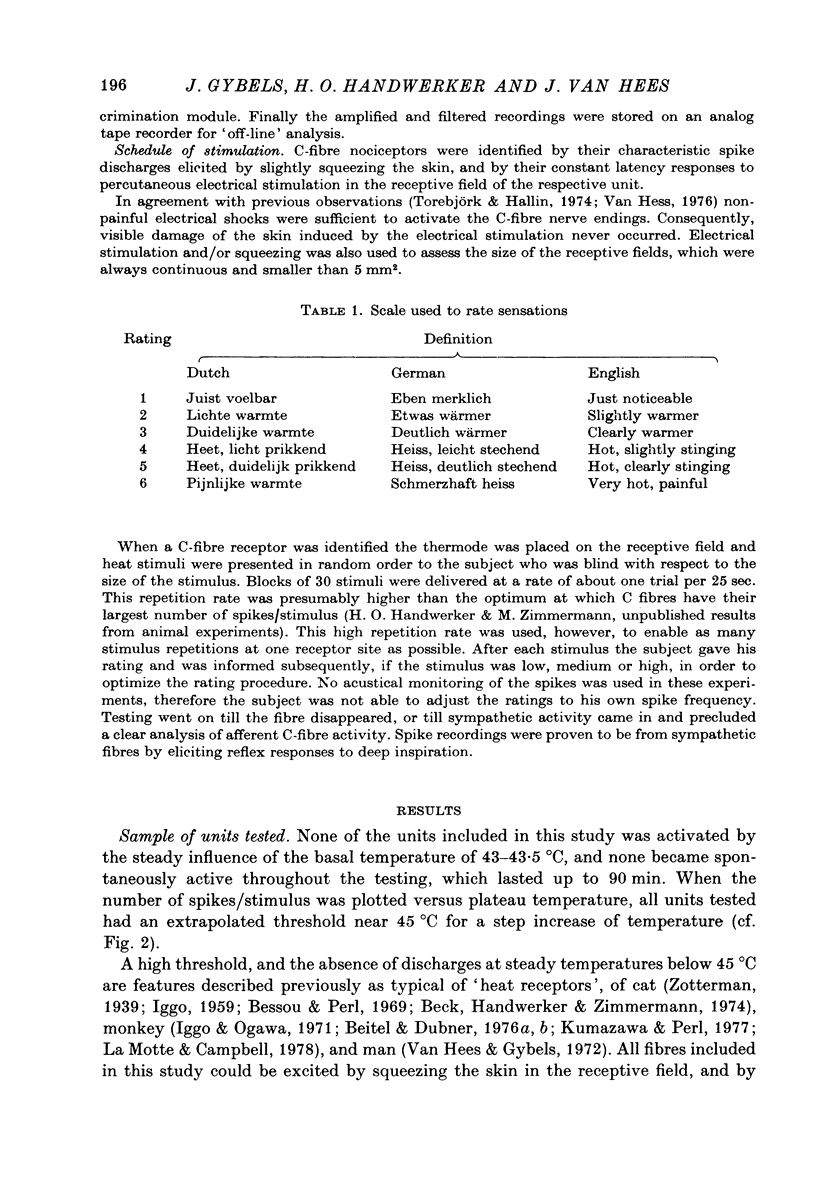Abstract
1. Impulses in cutaneous nerve fibres were recorded percutaneously with tungsten micro-electrodes from the superficial radial nerve of adult human subjects. 2. Eight units studied had conduction velocities below 1.5 m/sec, and thus belong to the class of C fibres. On the basis of their responsiveness to mechanical and to thermal stimuli the units were classified as 'polymodal nociceptors'. 3. Units were tested with 12 sec heat pulses starting from a base line temperature of 43.0-43.5 degrees C. Heat stimuli reaching three different maximal levels were applied in randomized order, the subjects being blind with respect to stimulus size. Each of the eight units studied was tested with more tha 20 stimuli and with four of them were 80-125 stimulus repetitions. 4. After each stimulus the subjects had to rate his sensations on a six-point rating scale extending from 'just noticeable' to 'very hot, painful'. 5. Discrimination between the three stimulus levels by the integtated spike discharges and by the ratings of the subject was compared using the P(A) measure of the Signal Detection Theory. It was found that both the neurophysiological and the psychophysical measurements provided about equal discrimination. 6. In addition it has been found that spike discharges and ratings share a common variance beyond their common dependence on the stimulus level. Among the factors contributing to this interdependence a 'temporal position effect' was the most significant. 7. In spite of this interdependence between discharge rates and subjective ratings, the latter gave a better estimation of the stimulus size than of the discharge rates of the individual C fibre under study. 8. It was concluded that the polymodal C-nociceptors might be instrumental for the quantitative aspects of heat pain sensation. The hypothesis was derived from the present results that, under the conditions of cour experiments, the loss of information in the course of central processing might be about equal to the gain by the parallel processing in a population of nociceptors excited by a stimulus.
Full text
PDF













Selected References
These references are in PubMed. This may not be the complete list of references from this article.
- Beck P. W., Handwerker H. O., Zimmermann M. Nervous outflow from the cat's foot during noxious radiant heat stimulation. Brain Res. 1974 Mar 8;67(3):373–386. doi: 10.1016/0006-8993(74)90488-0. [DOI] [PubMed] [Google Scholar]
- Beitel R. E., Dubner R. Fatigue and adaptation in unmyelinated (C) polymodal nociceptors to mechanical and thermal stimuli applied to the monkey's face. Brain Res. 1976 Aug 13;112(2):402–406. doi: 10.1016/0006-8993(76)90295-x. [DOI] [PubMed] [Google Scholar]
- Beitel R. E., Dubner R. Response of unmyelinated (C) polymodal nociceptors to thermal stimuli applied to monkey's face. J Neurophysiol. 1976 Nov;39(6):1160–1175. doi: 10.1152/jn.1976.39.6.1160. [DOI] [PubMed] [Google Scholar]
- Bessou P., Perl E. R. Response of cutaneous sensory units with unmyelinated fibers to noxious stimuli. J Neurophysiol. 1969 Nov;32(6):1025–1043. doi: 10.1152/jn.1969.32.6.1025. [DOI] [PubMed] [Google Scholar]
- DOUGLAS W. W., RITCHIE J. M. Mammalian nonmyelinated nerve fibers. Physiol Rev. 1962 Apr;42:297–334. doi: 10.1152/physrev.1962.42.2.297. [DOI] [PubMed] [Google Scholar]
- IGGO A. Cutaneous heat and cold receptors with slowly conducting (C) afferent fibres. Q J Exp Physiol Cogn Med Sci. 1959 Oct;44:362–370. doi: 10.1113/expphysiol.1959.sp001417. [DOI] [PubMed] [Google Scholar]
- Iggo A., Ogawa H. Primate cutaneous thermal nociceptors. J Physiol. 1971 Jul;216(2):77P–78P. [PubMed] [Google Scholar]
- Konietzny F., Hensel H. The dynamic response of warm units in human skin nerves. Pflugers Arch. 1977 Jul 29;370(1):111–114. doi: 10.1007/BF00707956. [DOI] [PubMed] [Google Scholar]
- Kumazawa T., Perl E. R. Primate cutaneous sensory units with unmyelinated (C) afferent fibers. J Neurophysiol. 1977 Nov;40(6):1325–1338. doi: 10.1152/jn.1977.40.6.1325. [DOI] [PubMed] [Google Scholar]
- LaMotte R. H., Campbell J. N. Comparison of responses of warm and nociceptive C-fiber afferents in monkey with human judgments of thermal pain. J Neurophysiol. 1978 Mar;41(2):509–528. doi: 10.1152/jn.1978.41.2.509. [DOI] [PubMed] [Google Scholar]
- Rang H. P., Ritchie J. M. On the electrogenic sodium pump in mammalian non-myelinated nerve fibres and its activation by various external cations. J Physiol. 1968 May;196(1):183–221. doi: 10.1113/jphysiol.1968.sp008502. [DOI] [PMC free article] [PubMed] [Google Scholar]
- Torebjörk H. E. Afferent C units responding to mechanical, thermal and chemical stimuli in human non-glabrous skin. Acta Physiol Scand. 1974 Nov;92(3):374–390. doi: 10.1111/j.1748-1716.1974.tb05755.x. [DOI] [PubMed] [Google Scholar]
- Torebjörk H. E., Hallin R. G. Identification of afferent C units in intact human skin nerves. Brain Res. 1974 Mar 8;67(3):387–403. doi: 10.1016/0006-8993(74)90489-2. [DOI] [PubMed] [Google Scholar]
- Torebjörk H. E., Hallin R. G. Perceptual changes accompanying controlled preferential blocking of A and C fibre responses in intact human skin nerves. Exp Brain Res. 1973 Jan 29;16(3):321–332. doi: 10.1007/BF00233334. [DOI] [PubMed] [Google Scholar]
- Vallbo A. B., Hagbarth K. E. Activity from skin mechanoreceptors recorded percutaneously in awake human subjects. Exp Neurol. 1968 Jul;21(3):270–289. doi: 10.1016/0014-4886(68)90041-1. [DOI] [PubMed] [Google Scholar]
- Van Hees J., Gybels J. M. Pain related to single afferent C fibers from human skin. Brain Res. 1972 Dec 24;48:397–400. doi: 10.1016/0006-8993(72)90198-9. [DOI] [PubMed] [Google Scholar]
- Zotterman Y. Touch, pain and tickling: an electro-physiological investigation on cutaneous sensory nerves. J Physiol. 1939 Feb 14;95(1):1–28. doi: 10.1113/jphysiol.1939.sp003707. [DOI] [PMC free article] [PubMed] [Google Scholar]


